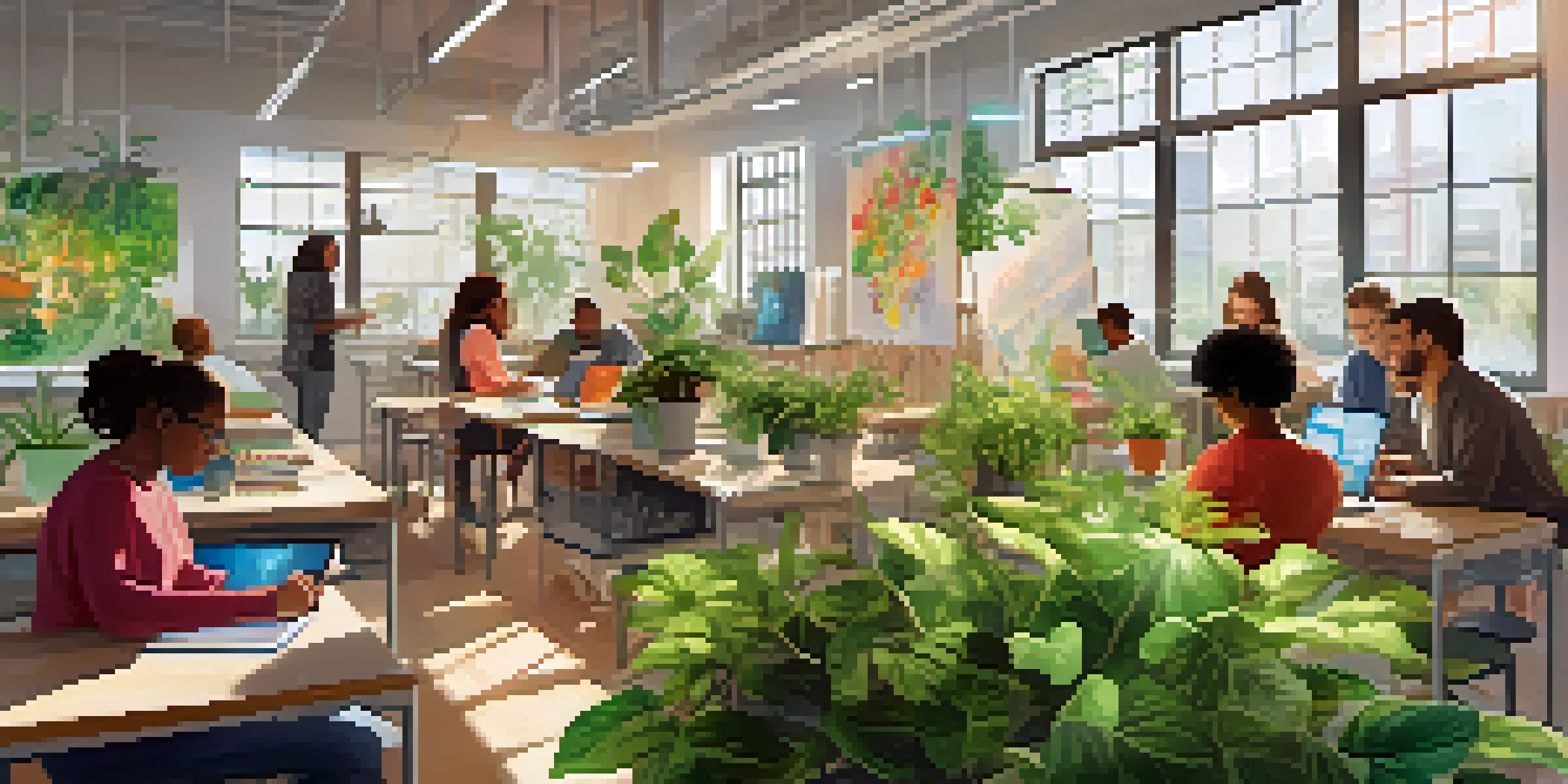Interdisciplinary Learning: Addressing Global Challenges Collectively

Understanding Interdisciplinary Learning and Its Importance
Interdisciplinary learning is an educational approach that integrates knowledge and skills from different disciplines to address complex issues. It's like piecing together a puzzle where each piece represents a different field of study, coming together to create a complete picture. For instance, tackling climate change requires insights from science, economics, and social studies, showcasing how interconnected our challenges are.
Education is the most powerful weapon which you can use to change the world.
This method encourages collaboration among various experts, fostering a richer understanding of global challenges. By breaking down the silos that often exist between disciplines, we can approach problems from multiple angles. This holistic perspective not only enhances learning but also prepares students and professionals to think critically and creatively in real-world scenarios.
Moreover, interdisciplinary learning nurtures essential skills such as teamwork, communication, and problem-solving. These skills are crucial in today's job market, where employers seek individuals who can navigate complex issues collaboratively. In this way, interdisciplinary learning not only addresses global challenges but also equips learners with the tools they need for future success.
Global Challenges: Defining the Landscape
Today's world faces a myriad of global challenges, from climate change and poverty to health crises and social injustice. These issues are often interconnected, meaning a solution in one area can have ripple effects in another. For example, improving education in a region can lead to better health outcomes and economic growth, illustrating the complexity of these challenges.

Recognizing the interdependence of these global issues allows us to approach them with a comprehensive mindset. It’s not just about addressing a single problem; it’s about understanding how solutions can overlap and reinforce one another. This interconnected approach is essential for creating sustainable change that benefits communities worldwide.
Interdisciplinary Learning Defined
Interdisciplinary learning integrates knowledge from various fields to tackle complex global challenges.
Furthermore, the urgency of these challenges calls for immediate and innovative solutions. Traditional methods may fall short, making it crucial to harness the collective knowledge from multiple disciplines. By doing so, we can develop more effective strategies that address the root causes of these issues, rather than just treating the symptoms.
Examples of Successful Interdisciplinary Initiatives
There are numerous examples of successful interdisciplinary initiatives across the globe that highlight the power of collective problem-solving. One such initiative is the United Nations' Sustainable Development Goals (SDGs), which bring together diverse stakeholders to tackle pressing global issues like clean water, education, and gender equality. Each goal requires input from various fields, demonstrating the effectiveness of interdisciplinary collaboration.
The whole is greater than the sum of its parts.
Another inspiring example is the collaboration between environmental scientists, urban planners, and community activists to create sustainable cities. This teamwork produces innovative solutions that consider ecological impact, social needs, and economic viability, ultimately leading to healthier urban environments. Such projects reveal how pooling expertise can lead to breakthroughs that no single discipline could achieve alone.
These initiatives not only address specific challenges but also serve as models for future collaborations. They illustrate how interdisciplinary learning can inspire new ways of thinking and problem-solving, setting a precedent for how we approach global challenges moving forward. By showcasing real-world examples, we can motivate others to adopt this collaborative mindset in their own endeavors.
The Role of Education in Fostering Interdisciplinary Learning
Education plays a pivotal role in fostering interdisciplinary learning, shaping how future generations approach global challenges. By integrating various subjects in the curriculum, educators can encourage students to think outside the box and draw connections between fields. For example, a project that combines science and art can help students understand environmental issues through creative expression.
Moreover, experiential learning opportunities, such as internships or community projects, can reinforce interdisciplinary concepts. When students work on real-world problems alongside professionals from different backgrounds, they gain practical insights that enhance their academic experience. This hands-on approach not only solidifies their understanding but also highlights the importance of collaboration in real-life scenarios.
Global Challenges Demand Collaboration
Addressing interconnected global issues requires innovative solutions that draw from multiple disciplines.
Educational institutions are increasingly recognizing the value of interdisciplinary programs and are actively seeking ways to implement them. By promoting a culture of collaboration and critical thinking, we can prepare students to tackle the complex challenges they will face in the future. This shift in education not only benefits individuals but also contributes to a more innovative and resilient society.
Challenges in Implementing Interdisciplinary Learning
While the benefits of interdisciplinary learning are clear, implementing it can come with its own set of challenges. One major hurdle is the traditional structure of educational institutions, which often emphasizes specialization within individual disciplines. This can create resistance to collaborative approaches, as educators may feel pressure to adhere strictly to their own subject areas.
Additionally, there may be a lack of resources or support for interdisciplinary initiatives. Schools and universities may struggle to find the funding or training necessary to develop and sustain these programs. This can lead to a fragmented approach where interdisciplinary efforts are sporadic rather than integrated into the curriculum.
Despite these challenges, the growing recognition of the need for interdisciplinary approaches offers hope. As more institutions and organizations advocate for collaboration, there is potential for meaningful change. By addressing these obstacles head-on, we can create a more conducive environment for interdisciplinary learning to thrive.
The Future of Interdisciplinary Learning
As we look to the future, interdisciplinary learning is poised to play a crucial role in addressing global challenges. The increasing complexity of issues such as climate change, public health, and inequality demands innovative solutions that draw from multiple disciplines. By embracing this collaborative approach, we can foster a generation of thinkers who are equipped to tackle these pressing problems.
Moreover, advancements in technology and communication are making interdisciplinary collaboration more accessible than ever. Online platforms enable individuals from different fields to connect and share ideas, fostering a global community of problem solvers. This interconnectedness allows for diverse perspectives, enriching discussions and leading to more comprehensive solutions.
Education's Role in Collaboration
Educational institutions are crucial in fostering interdisciplinary learning by integrating diverse subjects and promoting teamwork.
Ultimately, the future of interdisciplinary learning lies in our ability to adapt and innovate. By continuing to break down barriers between disciplines and encouraging collaboration, we can create a brighter future for individuals and communities around the world. Embracing this mindset not only enhances our educational systems but also empowers us to face global challenges collectively.
How You Can Contribute to Interdisciplinary Solutions
You don’t have to be an expert to contribute to interdisciplinary solutions; everyone has a role to play. Start by seeking out opportunities to collaborate with others from different backgrounds or fields. Whether it’s through community projects, workshops, or online forums, engaging with diverse perspectives can inspire fresh ideas and approaches.
Additionally, consider advocating for interdisciplinary learning in your local schools or organizations. Encouraging educators and leaders to integrate collaborative strategies can help foster a culture of teamwork and innovation. Your voice can make a difference, pushing for changes that benefit not only students but also the broader community.

Lastly, stay informed about global challenges and the interdisciplinary initiatives addressing them. Knowledge is power, and understanding these issues allows you to engage meaningfully in conversations and actions. By actively participating in the dialogue, you can contribute to a collective effort to tackle the complex problems facing our world today.